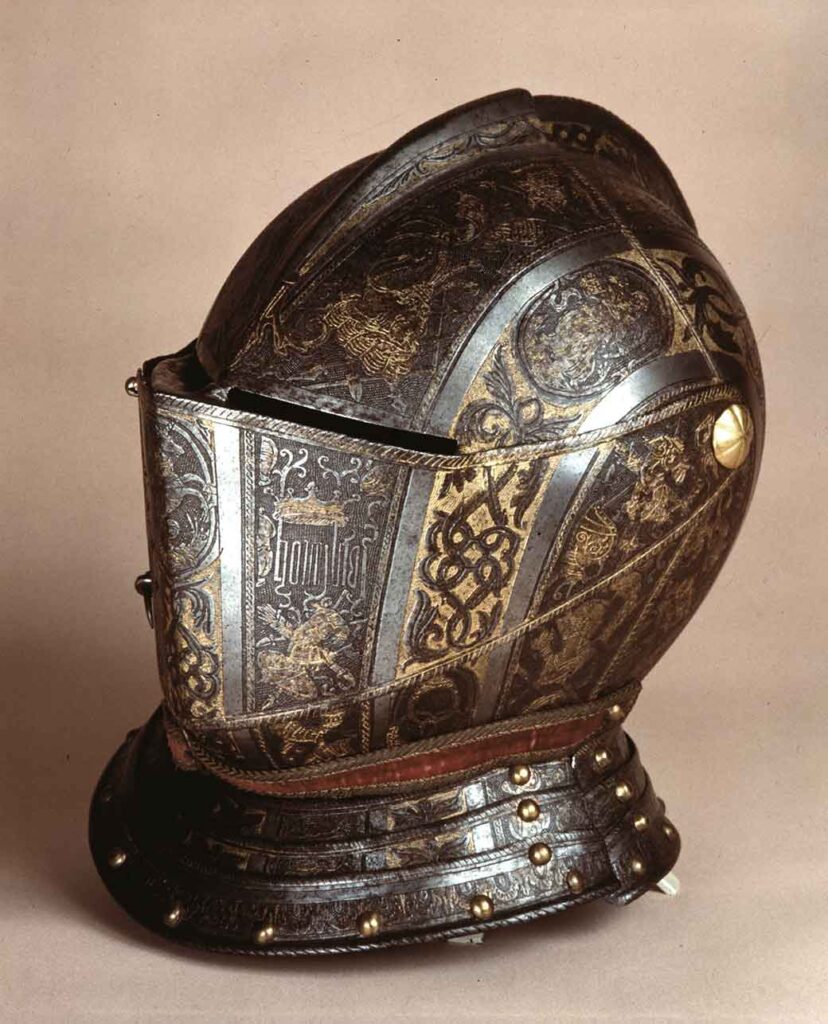Borromeo Helmet
Pompeo della Cesa , ca. 1585 - 1590
Description

The helmet is decorated by series of engraved bands, separated by unworked laths. The panels depict the feats of the liocorn between intertwined rings and the equine bite and the motto “Homylitas,” all of which are related to the Borromeos. There is also Santa Giustina, claimed by the family among their ancestors. The helmet belongs to a suit of armor likely made for Renato I Borromeo (1555-1608), who was captain of men-at-arms in 1591 and ambassador to King Philip III of Spain in 1598. He was brother of Cardinal Federico and had married Ersilia Farnese, sister of the Duke of Parma, Alessandro, in 1579. The decoration was done with engravings made with the etching technique and later partly darkened and gilded. Other elements of the same armor, on which Pompeo della Cesa’s signature also appears, are in the Stibbert Museum in Florence.
Data Sheet
Author
Pompeo della Cesa, ca. 1537- 1610
Date
ca. 1585 - 1590
Material and technique
Engraved and gilded steel
Measures
3.073 g
Acquisition
Gian Giacomo Poldi Pezzoli bequest, 1879
Inventory number
2592
location
Armoury
The Hall of Arms was the first room set up in the House Museum and was located on the main floor, in the Trivulzio Hall. The current layout, from 2000, is the work of the great sculptor Arnaldo Pomodoro, who interprets the theme of the armory by enhancing its historical identity. Gian Giacomo Poldi Pezzoli, a passionate collector of antique weapons, had entrusted the early work to architect Giuseppe Balzaretto and stage designer Filippo Peroni, with the collaboration of Paolo Gazzoli for the stucco work and Pompeo Bertini for the stained-glass windows. The theatrical effect of the Neo-Gothic style dominated the hall, crowded with banners, weapons, armor, trophies, display cases, and mannequins. The room was completely destroyed during World War II, and the precious objects moved to the ground floor. The collection consists mainly of pieces from the Milanese and Brescian Renaissance, with a focus on parade weapons. A second important group consists of German firearms from the 16th and 17th centuries.
collection
Arms and Armour
Arms and armour were the first passion of Gian Giacomo Poldi Pezzoli, who commissioned the set-up of a Neo-Gothic style crowded armoury. In the collection, there are about one thousand Western and Oriental arms and armours. Among them, stand out the Renaissance parade armours made in Milan by Pompeo della Cesa and the 16th century firearms from Brescia and Germany.
